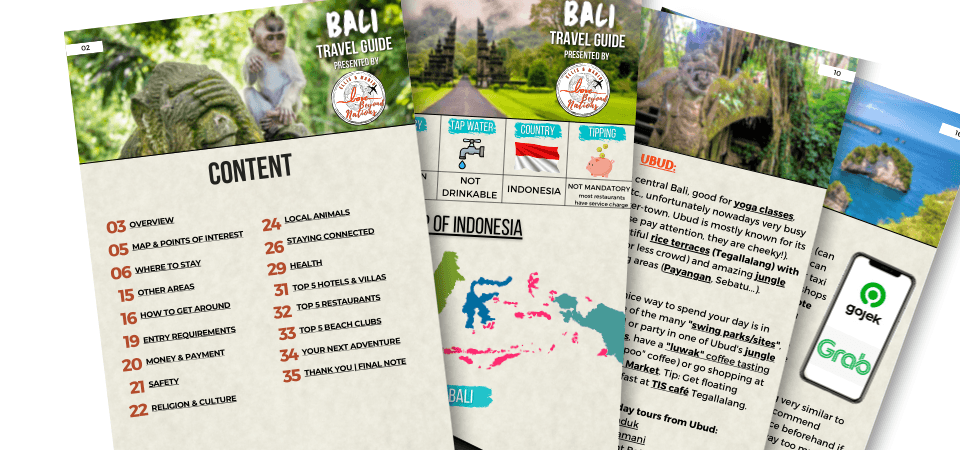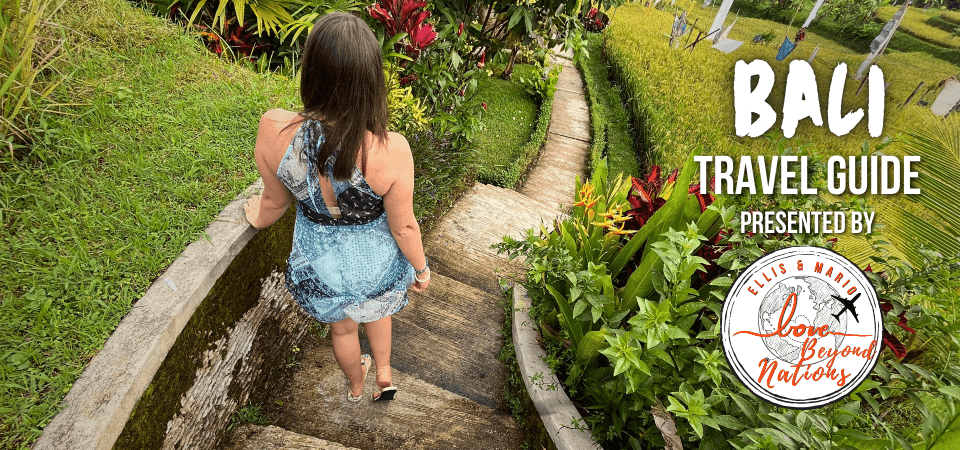Our first Bali trip was a mess. We sprinted between must-sees, missed the quiet magic, and flew home exhausted. This Bali Itinerary for 3 weeks is what we wish we had. It blends icons with quiet corners and avoids burnout. After six months on the island we learned what actually works. What follows is a clear daily plan with steps, timing, and reasons so you see the temples and beaches, find calm spaces, and still have energy when you fly home.
📌 Planning your Bali trip? Pin this guide now and read it later!
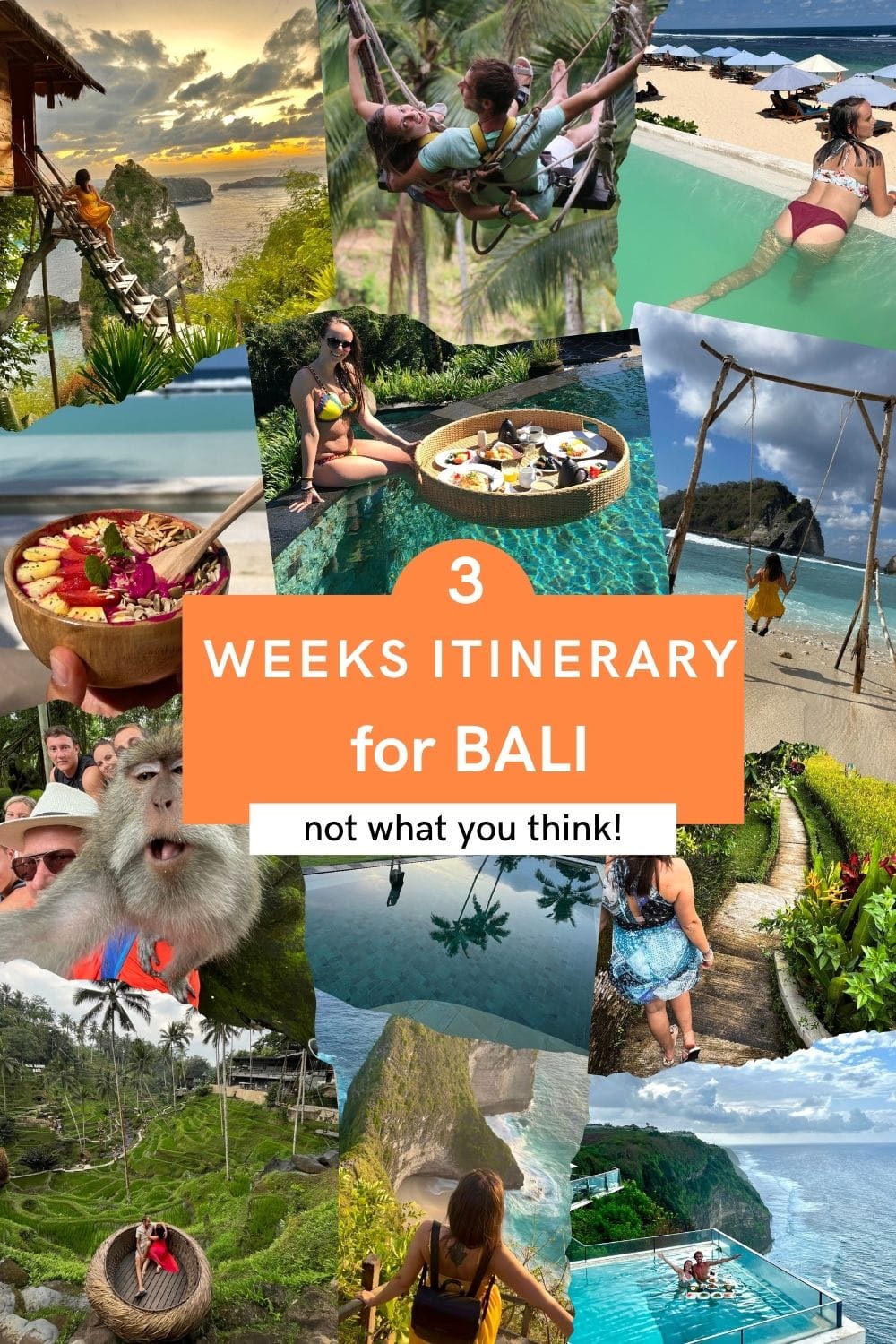
Chapters
×Why 3 Weeks in Bali Is Perfect
3 weeks in Bali strike a sweet spot: enough time to land gently, see the icons, and still enjoy quiet corners. You can cover the south, central heartlands, the north, and even the islands without feeling rushed, yet not so long that you burn out. This plan balances movement with rest, giving you temple days and beach days, but also slow mornings with coffee and rice‑field views. It’s designed so you finish your trip feeling enriched, not exhausted.
Quick Facts
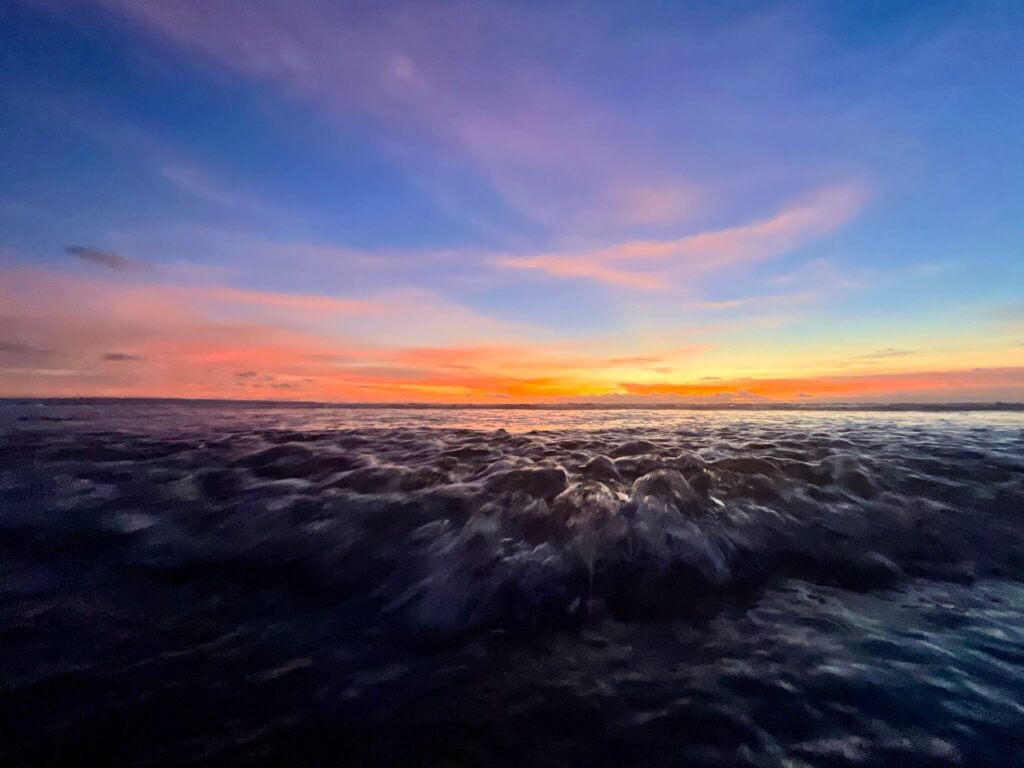
Uluwatu – Days 1 to 3
Day 1 – Arrival and first sunset
Naturally, arrival times to Bali vary, so keep this day flexible. Pre-book a driver through platforms like Klook so you skip bargaining at DPS and head straight to Uluwatu, about an hour away. After check-in and a shower, don’t plan too much. If you land early enough, pick one thing: a simple sunset.
Until mid-2025, Bingin’s cliff cafés were the classic choice, but most were demolished in a government crackdown. The beach itself remains beautiful and open to the public, but food and drink options are limited while the area is being reorganised. For now, you’re better off choosing an alternative:
- Padang Padang viewpoint (above the beach, still operational cafés)
- Suluban cliffs (near Single Fin, lively atmosphere)
- Or keep it very simple: sit right on the sand with a coconut or takeaway snacks and watch the sky shift.
If your flight lands late, skip the sunset altogether and enjoy a quiet evening meal at your hotel before an early night. Save temples and shows for tomorrow when you’re rested.
Day 2 – Beaches, cafés, and Uluwatu Temple
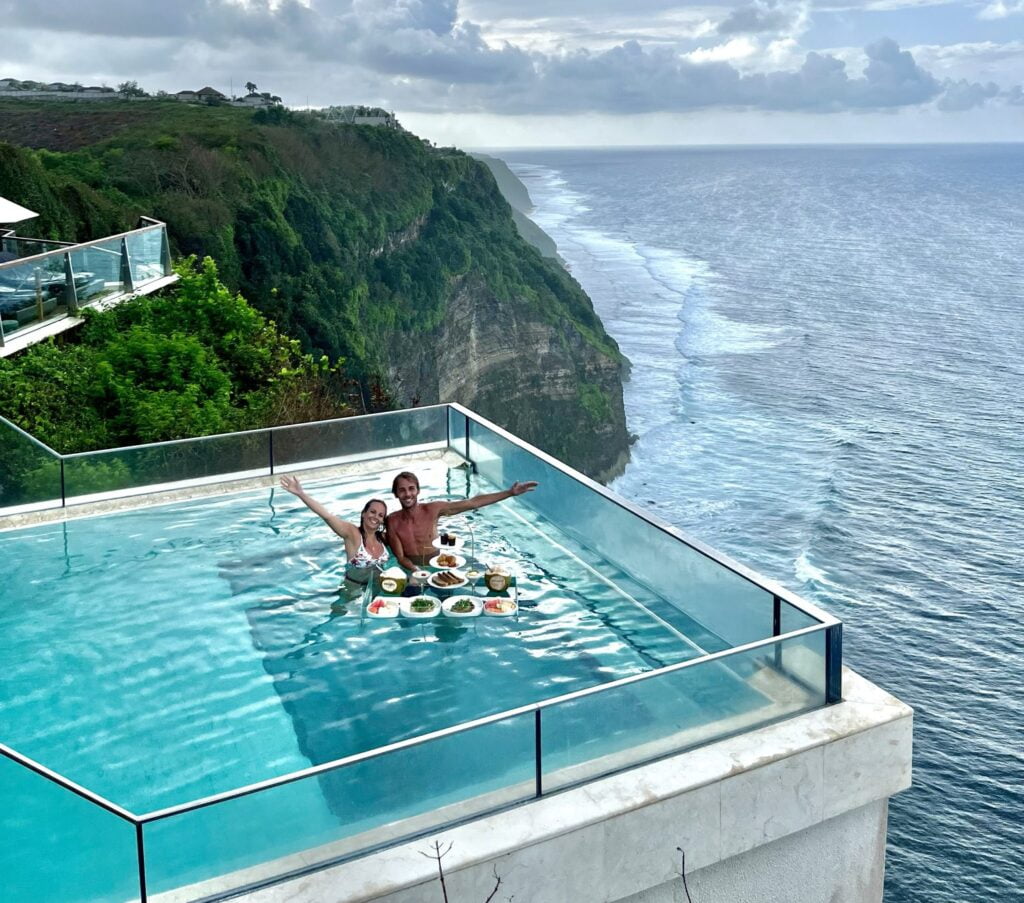
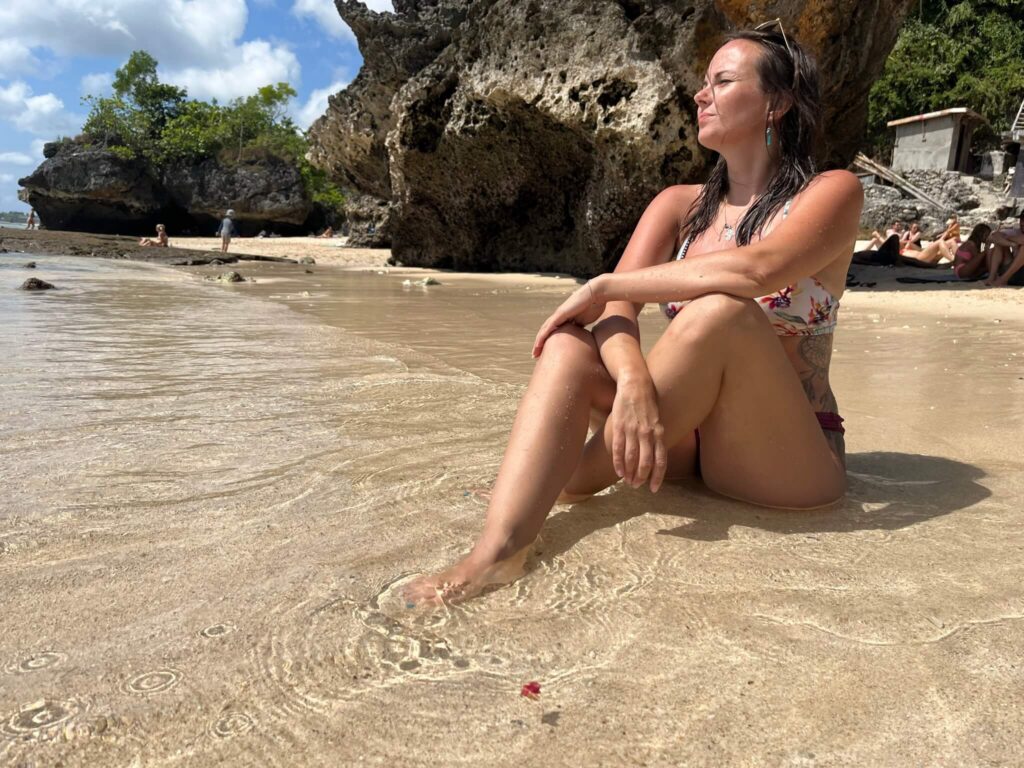
Start your morning at Padang Padang Beach before the tide rises and the crowds arrive (check tide times locally). It’s a small cove, famous for its surf breaks, and worth seeing early while it’s still calm.
Around midday shift to Thomas Beach for a swim and a relaxed lunch in one of the simple warungs, or head further south to Melasti Beach, where white sand and turquoise water stretch wide. Both beaches have facilities and more space than Padang Padang.
As the afternoon cools, move up to a cliff viewpoint near Suluban or Padang Padang for coconuts or coffee and settle in for the sunset. Getting around is easiest by scooter if you’re confident, but hiring a driver keeps things simple and safe.
Close the day at Uluwatu Temple, perched dramatically on a 70-meter cliff above the Indian Ocean. The temple itself is one of Bali’s six key spiritual sites and dedicated to the sea gods. Wander along the cliff path for sweeping views before the performance begins.
The Kecak fire dance is held in an open amphitheatre with the ocean as backdrop. Around 18:00, as the sun dips, more than a hundred men sit in concentric circles chanting “cak-cak-cak” in rhythm, recreating scenes from the Ramayana. The combination of chant, fire torches, and sunset over the ocean is unforgettable.
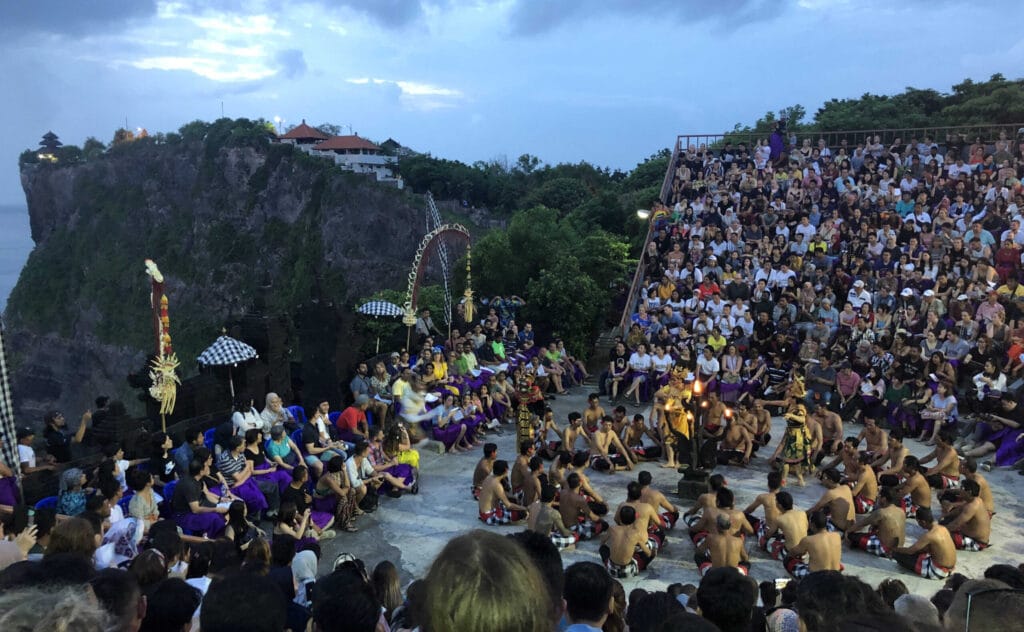
Practical tips:
- Tickets: available at the temple entrance (arrive by 17:00 to be sure). The tickets for the dance are sold separately at the temple. Normally your driver will get them for you while you explore the area!
- Seating: fills up fast; sit higher up for photos with both stage and sunset in frame.
- Dress: bring or borrow a sarong; shoulders should be covered.
- Safety: monkeys near the entrance love to snatch sunglasses, hats, and phones — keep them packed away.
- Transport back: traffic after the show can be heavy; if you’re using a driver, agree on a meeting point before entering.
Ending your first full day here ties together beaches, Balinese spirituality, and one of the island’s most atmospheric sunsets – the perfect start for your trip.
Day 3 – A splurge, surf, and spa
Start Day 3 with a splurge. You’ve made it to the Island of the Gods, and that deserves celebrating. If luxury appeals, we highly recommend The Edge. At IDR 7,000,000 per couple it isn’t cheap, but the package includes a floating breakfast for two in the cliff-edge pool and a 90-minute massage. The cliff views are spectacular, and the spa suite is among the most impressive in Bali, so book well in advance.
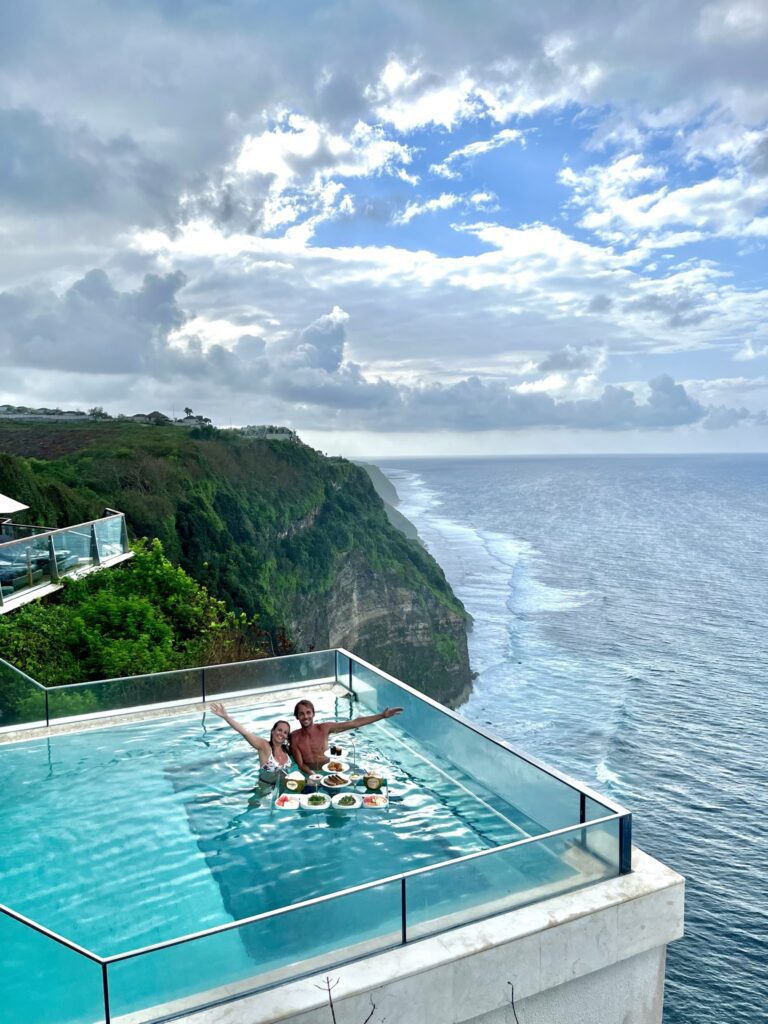
Afterwards, let the ocean shape your afternoon. If the waves line up around mid-tide, head to Padang Padang Right (Baby Padang) for a beginner surf lesson. Local schools provide boards and coaching, and the smaller sets here are forgiving for first-timers.
If surfing isn’t your thing, you won’t miss out. Thomas Beach stays laid-back with simple warungs and soft sand, perfect for an unhurried swim and a cold drink. Or, drive down to Melasti Beach, where calm turquoise water and tide pools make it one of the easiest places to relax on the Bukit.
Round out the day with a Balinese massage to loosen travel muscles, then dinner with a view on the cliffs. Keep it simple—you’ll want energy for the next leg of the trip.
For more ideas check our detailed Uluwatu guide.
Nusa Penida – Days 4 to 5
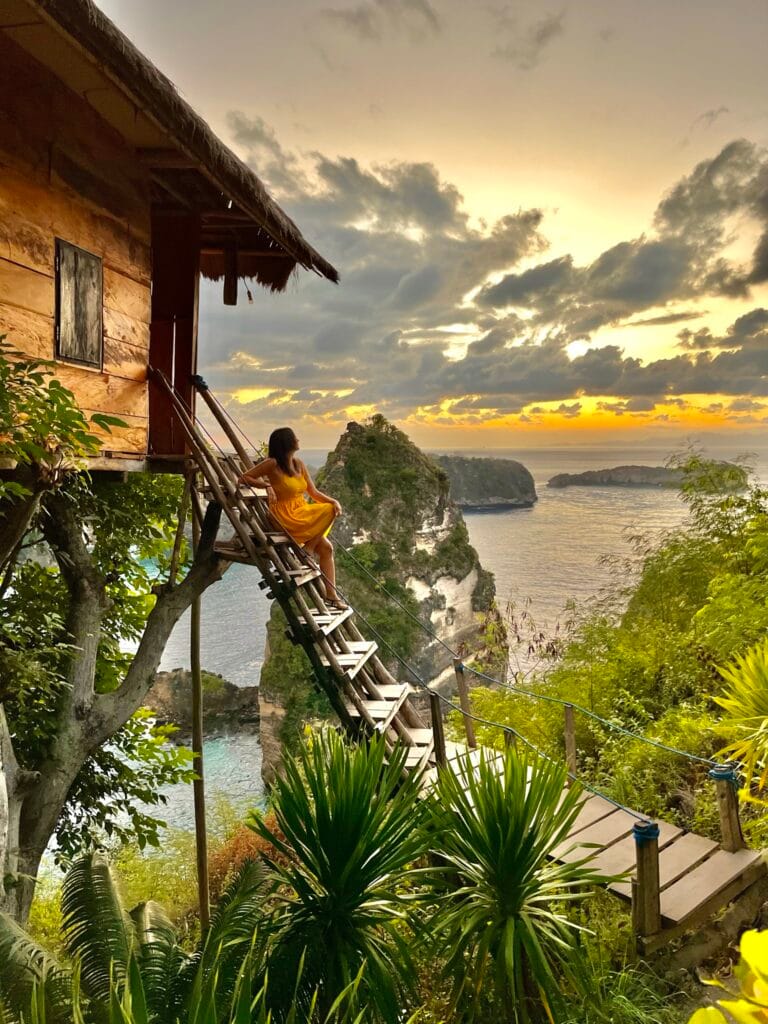
Day 4 – West coast views without the rush
Take a morning fast boat from Sanur harbor to Nusa Penida. Most operators run between 07:30 and 09:00, and the ride takes around 45 minutes. Arrive at the Sanur beach pier at least 30 minutes early for check-in and boarding. Tickets can be booked online or arranged through your hotel. If the sea looks rough, motion tablets are a smart precaution.
Once on Penida, remember the roads are steep and bumpy, so the easiest way to explore is by hiring a car with driver (about 1 Million IDR for two days). Plan your west coast loop from late morning to mid-afternoon. Start at Broken Beach, one of the island’s most photographed spots, where a natural stone arch frames turquoise water crashing against the cliffs.
Plan Bali Without Stress
Get our Bali Travel Guide 2025 – 30+ pages of real tips from 6+ months on the island.
📥 Download the Guide
The natural arch at Broken Beach frames turquoise water so vividly that each wave crashing into the cliffs makes you feel tiny against nature’s force. You can walk along the arch for different angles, but swimming in the pool below is strictly prohibited due to sudden rogue waves.
From here continue to Angel’s Billabong, a striking rock formation carved by the sea. Then aim to reach Kelingking Beach around 16:30. This is the sweet spot: the day-trippers are gone, the cliffs turn gold in the low light, and the place feels quiet and almost private. It’s exactly why an overnight stay on Penida is worth it.
For the night, we recommend Kabeh Jati Garden Villa – simple hillside cabins with peace, space, and a view of the island that balances out the busy day.
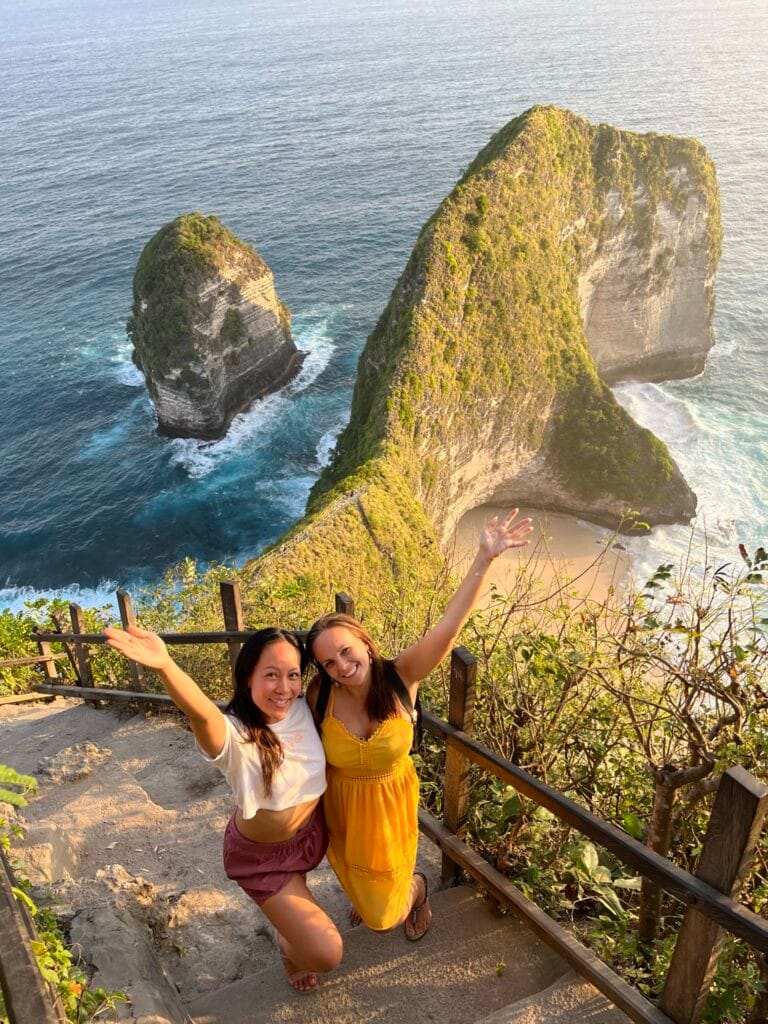
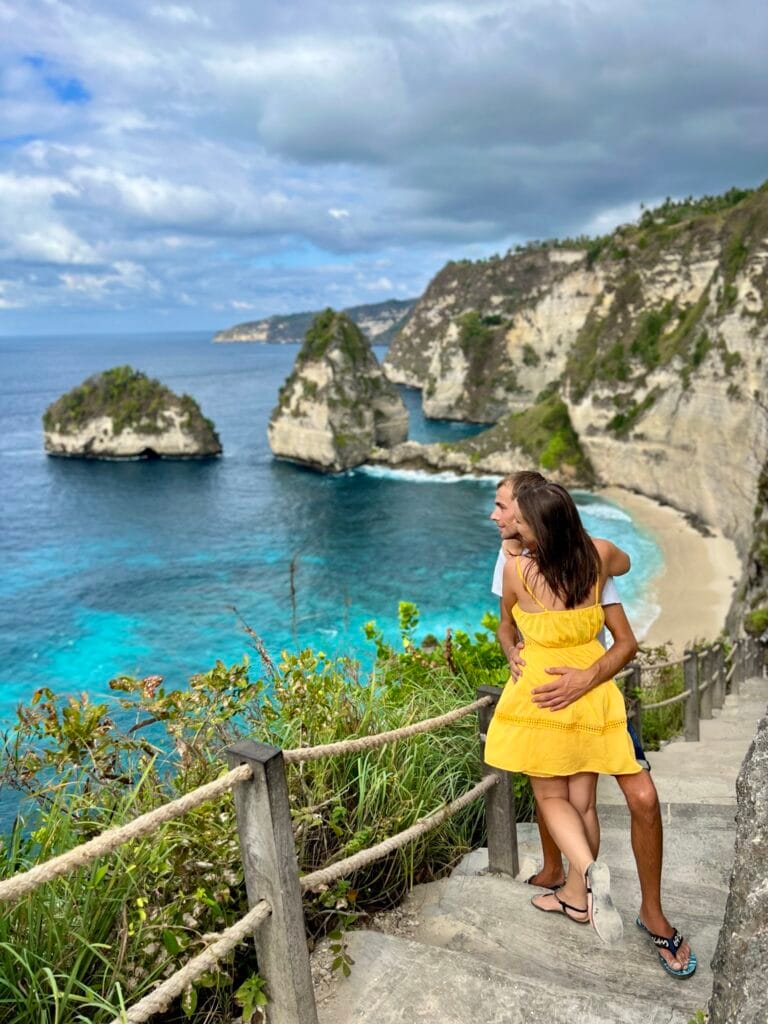
Day 5 – East Penida and on to the Gilis
Wake before sunrise and head to Rumah Pohon, the Thousand Islands viewpoint. From the little tree house you will see the first light wash over the cliffs and scattered islets, one of Penida’s most iconic views. Continue straight to Diamond Beach while the staircase is still shaded, then climb up to Atuh Cliff for a wider angle.
If the weather looks unstable by early afternoon, stay with the viewpoints and give yourself extra time to reach the pier. Roads on Penida are slow and winding, so build in a buffer.
Fast boats to the Gilis usually depart from late morning into the early afternoon, with crossings that take about two to three hours depending on sea conditions. Tickets are around IDR 400,000 to 500,000, but schedules vary with operator and season, so reconfirm the day before.
By late afternoon you will arrive on Gili Trawangan. Check in, drop your bags, and choose your pace. You can slip into the island’s party rhythm with beach bars and live music, or keep it quiet and rest up for tomorrow.
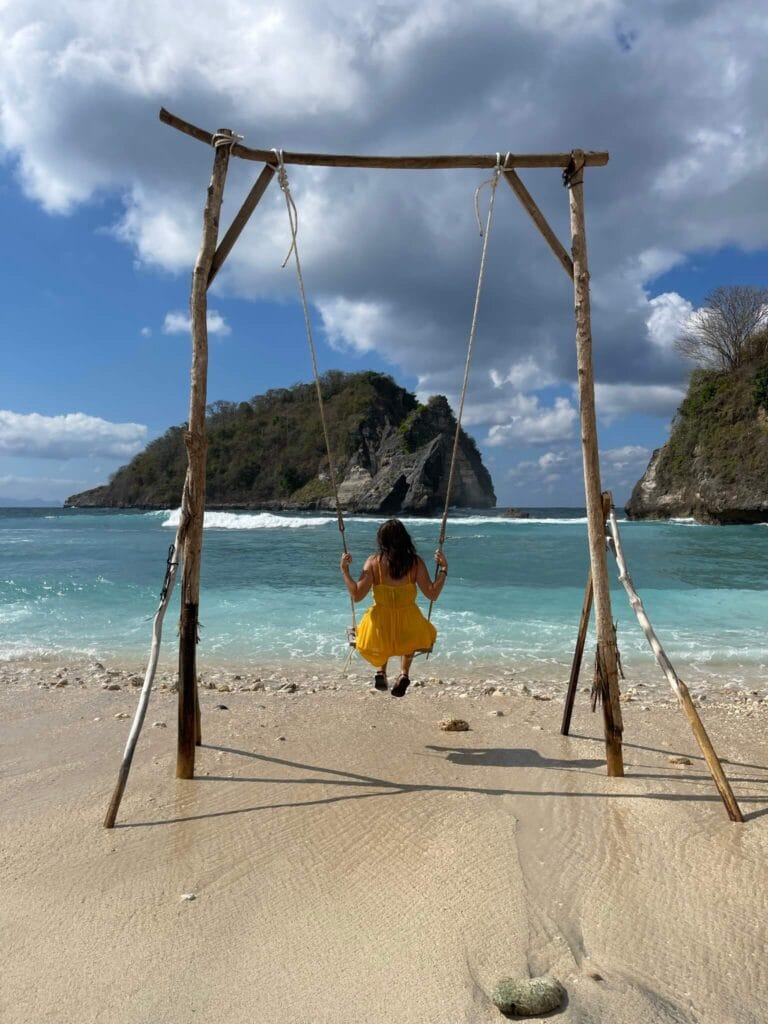
Remember that the Gili Islands belong to Lombok (West Nusa Tenggara), so the crossing depends on sea conditions and local operators. On the Island try to choose busy warungs and skip ice or raw salads to avoid stomach issues.
Gili Islands – Days 6 to 8
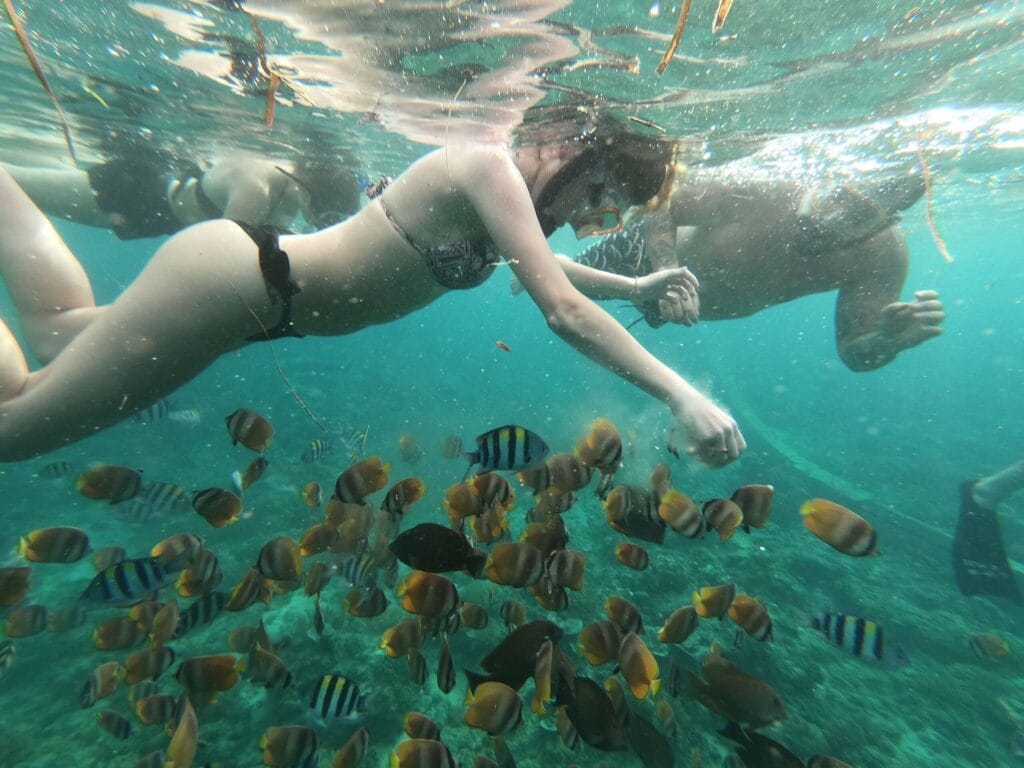
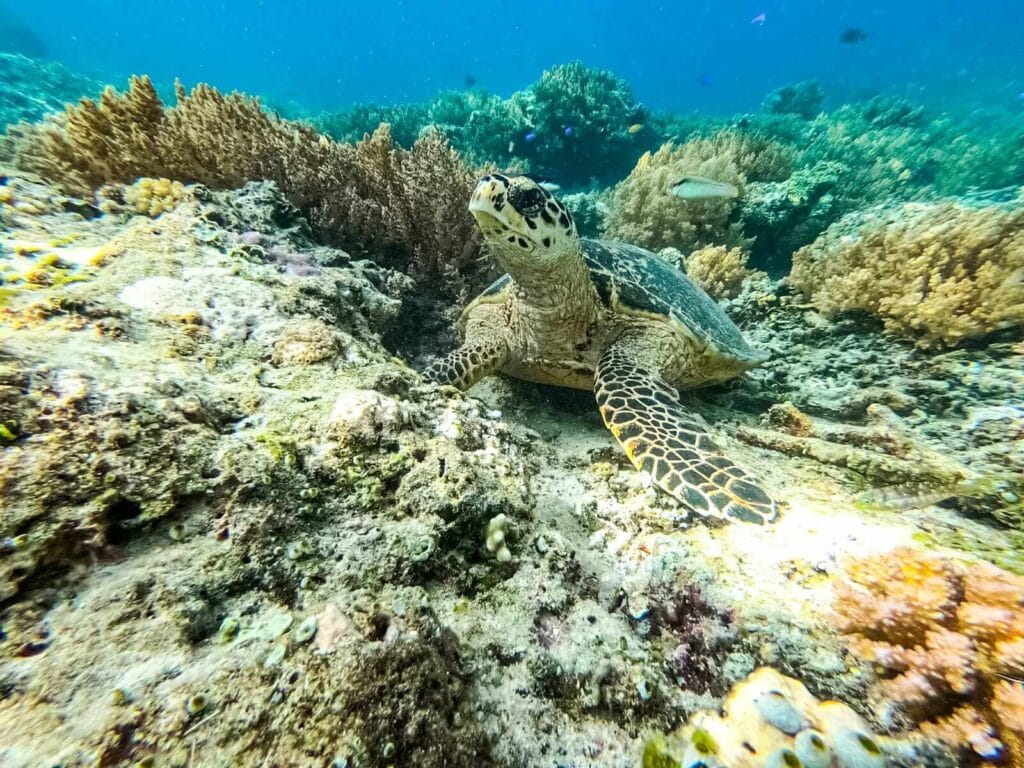
Day 6 – Let the island set your tempo
When on Gili Trawangan there are no cars or scooters, only bicycles and horse carts. Keep the pace easy. Rent a bike in the morning for about IDR 50,000 and circle the island with a couple of coffee stops, or point your wheels north where the beaches are quieter for a swim.
When the sun gets high, retreat to the shade for a nap and a simple lunch. As the light softens, wander to the west-coast swings for a drink and sunset. Fresh fish dinners served on the sand start around IDR 120,000, and the whole island keeps an unhurried rhythm.
After dark, Gili T wakes up. Sama Sama Reggae Bar hosts live bands, Tir Na Nog draws a crowd near the harbour, and the east shore often turns into a string of beach parties or the occasional silent disco. If you want something wilder, check the weekly boat parties departing from the main pier.
Day 7 – Snorkel day with turtles
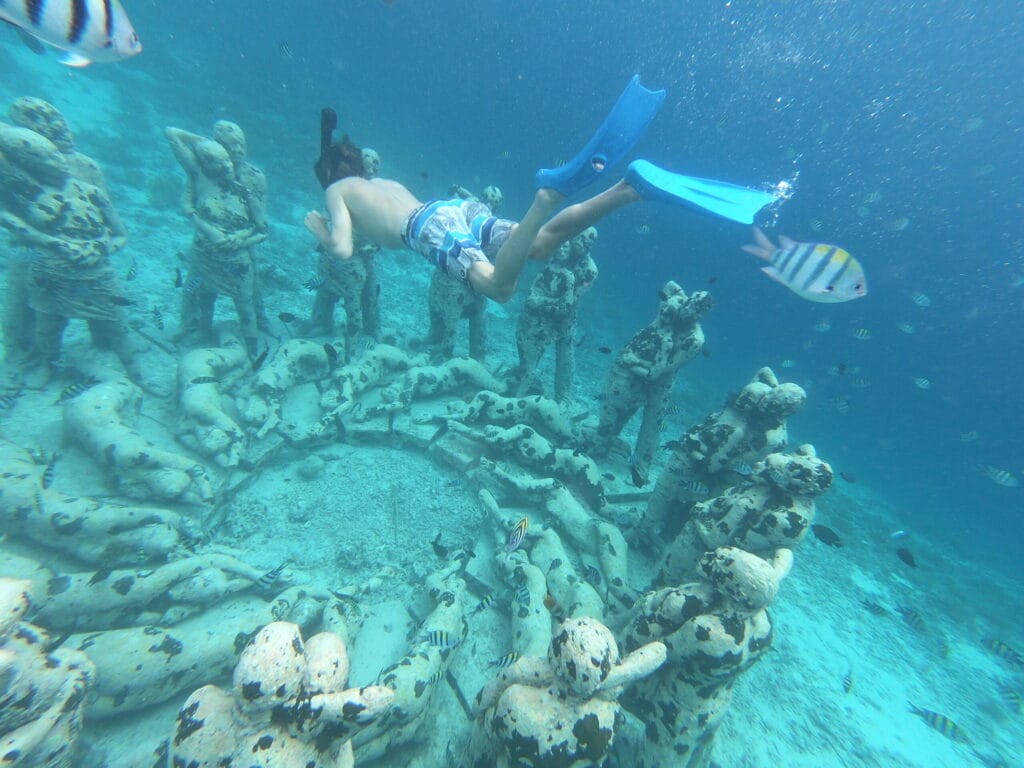
Book a half-day snorkel trip in the late morning (IDR 150,000–250,000). The boats usually stop at the underwater statues off Gili Meno, a coral garden, and the turtle points between Gili T and Gili Air. Masks, fins, and safety briefings are included.
If currents feel too strong or visibility is cloudy, ask the captain to choose a gentler site or simply enjoy the ride. Wear reef-safe sunscreen and a rash guard to avoid burns, and keep your camera in a dry bag. Floating beside a turtle in clear water is one of those Bali moments you won’t forget.
You’ll be back on Gili T by early afternoon. Rest, recharge, and save some appetite for the night market near the harbour. Grilled fish, satay skewers, and Indonesian classics are served for a fraction of restaurant prices. If you have energy later, wander back to the beach bars you missed the night before, or just follow the music drifting along the shoreline.
Day 8 – Hammocks and the crossing back
Set your alarm early and hop on your rental bike. Ride the island loop west in the cool dawn air. If you go really early you might need a flashlight or your phone light because the paths are bumpy and gravel. The famous swings in front of Hotel Ombak Sunset stand just offshore. While most people queue at sunset, sunrise gives you something different: calm water, soft light, and often the swings completely empty. The sun rises behind you, so the feeling is totally different. You can also go the evening before for sunset. It will be crowded but still beautiful. Sunrise is the chance to take that iconic photo without a line of people waiting.
Afterwards, reward yourself with coffee and a light breakfast back in town. Spend the rest of the morning however you like: swing in a hammock, take a final swim, or join a yoga class at one of the guesthouses.
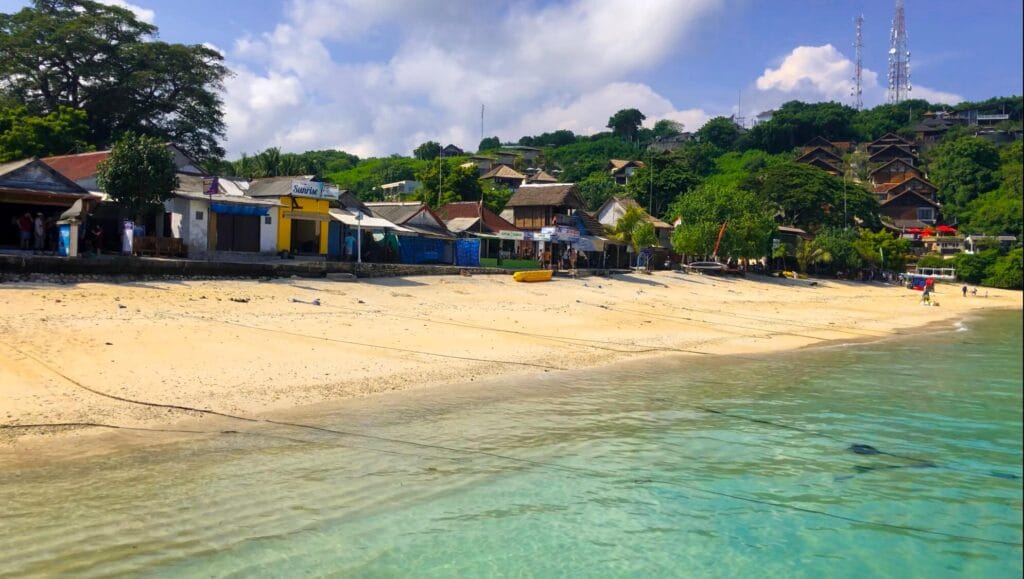
Boats back to Bali usually leave from late morning to early afternoon (2–3 hours, IDR 400,000–500,000). Confirm your ticket the day before and allow extra time for check-in.
By afternoon you’ll land back on Bali and head straight into the calm of Sidemen for the next stage of your trip.
Arrange a driver from Padang Bai or Sanur harbor to Sidemen (about 2 hours, IDR 500,000–600,000). The road winds through villages and rice terraces, already calmer than the coast. Check into a bamboo villa such as Wapa di Ume Sidemen or Sawah Indah.
Fun fact: Sleeping in on the Gilis can be tricky. Roosters start crowing before sunrise and the daily prayers at 6 am carry across the island. Bring earplugs if you’re a light sleeper, or just embrace the early wake-up call and enjoy a quiet beach walk before the crowds.
Sidemen – Days 9 to 10
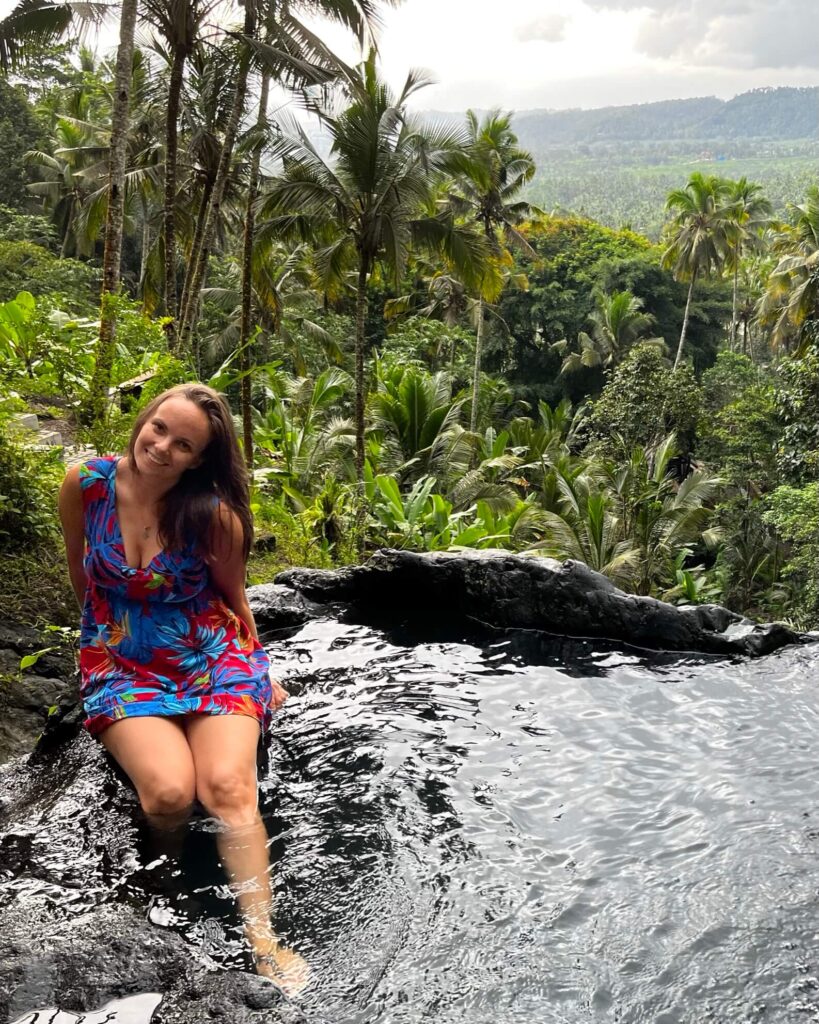
Day 9 – Slow morning and Silver class
On Day 9 it’s time to slow down. Sidemen moves at a different rhythm than the coast, and that is exactly the point of being here. Wake up to rice-field views, breathe the cooler air, and listen to the valley come alive with farmers heading into the fields. Roads are quiet, mornings stretch long, and life feels unhurried. Stay in a bamboo villa such as Wapa di Ume Sidemen or Sawah Indah and let the day begin gently with tea or coffee on your porch.
In the afternoon join a silver jewelry workshop in nearby Celuk village, famous for its silversmiths. Classes last 2–3 hours and let you design and craft your own ring or pendant. Later walk the narrow paths through the fields toward Telaga Waja River. Entry is free, but bring small cash for coconuts or snacks. Sunset here feels like Bali fifty years ago. On our scooters this road felt like couples therapy: less noise, more horizon, and the reason Sidemen belongs on a three‑week plan.
⚠️ Getting to the silver class (Celuk): You don’t need your own scooter. Book the workshop with pickup or ask your villa to arrange a driver. The route from Sidemen to Celuk is long and winding; a car is safer and more relaxed. Keep scooters for short rides inside Sidemen.
Day 10 – Water palace, hidden waterfall, and the road to Ubud
After breakfast, check out and begin the journey with either a private driver or your own scooter if you feel confident on Bali’s roads. Instead of heading straight to Ubud, the route first takes you east to some of the island’s most striking landmarks before turning inland.
The first stop is Tirta Gangga, the former royal water palace. Arrive early to step across the koi ponds, admire the tiered fountains, and enjoy the gardens before the larger tour groups appear.
Continue a little further east to Taman Ujung Water Palace. This site is larger and quieter than Tirta Gangga, with pools, bridges, and pavilions that stretch toward the sea while Mount Agung rises in the background. Allow at least an hour here to wander and take photographs.
On the way inland, pause at Gembleng Waterfall. A short climb leads to a natural infinity pool carved into the rock, overlooking the rice terraces below. It is a refreshing stop before continuing the drive.
Before reaching Ubud, make one last stop at one of the Sidemen viewpoints (e.g. Bukit Cinta or Lahangan Sweet). These bamboo decks are built high above the valley and frame Mount Agung behind the rice fields. They are popular photo spots, but the panorama is worth it even without a camera.
From here the road carries you directly to Ubud. The final stretch takes around an hour and a half depending on traffic, bringing you into Bali’s cultural heart by mid or late afternoon. Check into your hotel and settle in for the next chapter of your journey.
Ubud – Days 11 to 14
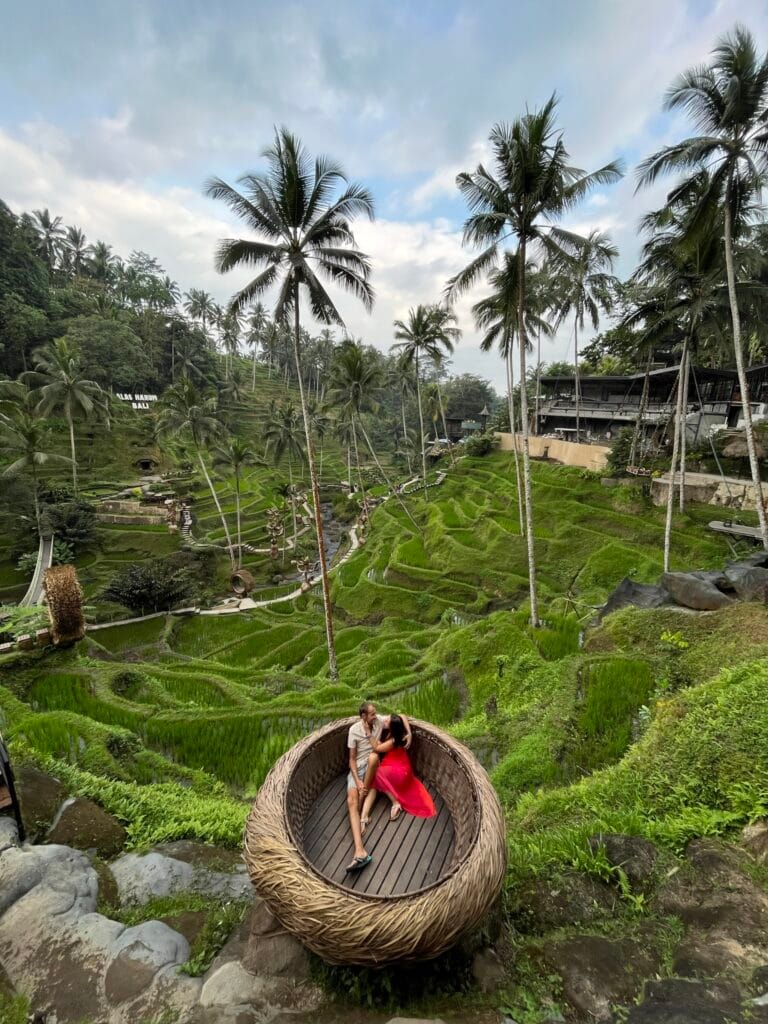
Day 11 – Monkey Forest, Tegalalang, Cooking Class
Be at the Ubud Monkey Forest right when it opens to enjoy the cooler air and quieter paths. The highlight for us was the water pond where the monkeys splash and play. You can spend ages just watching them chase each other. If you are curious about the famous monkey selfie, ask one of the local guides inside. They will help coax a monkey into the frame for a small fee, and it makes for a fun memory.
⚠️ Warning: Monkeys here are quick to snatch sunglasses, bottles, or even phones. Keep everything tucked away and avoid feeding or touching them.
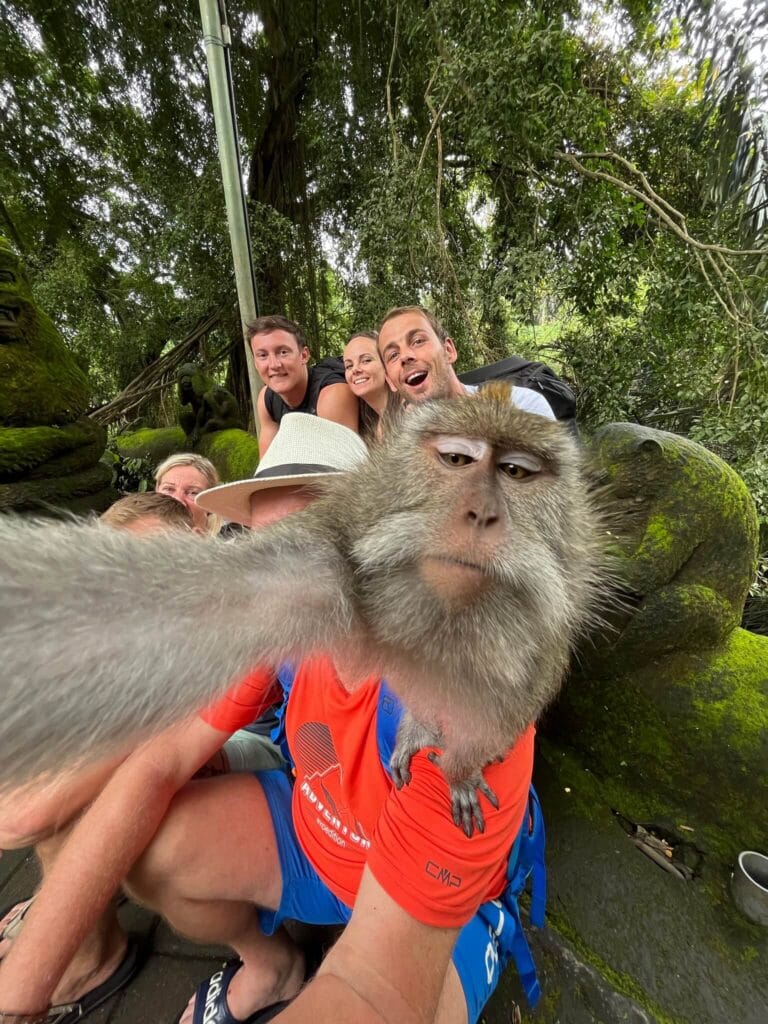
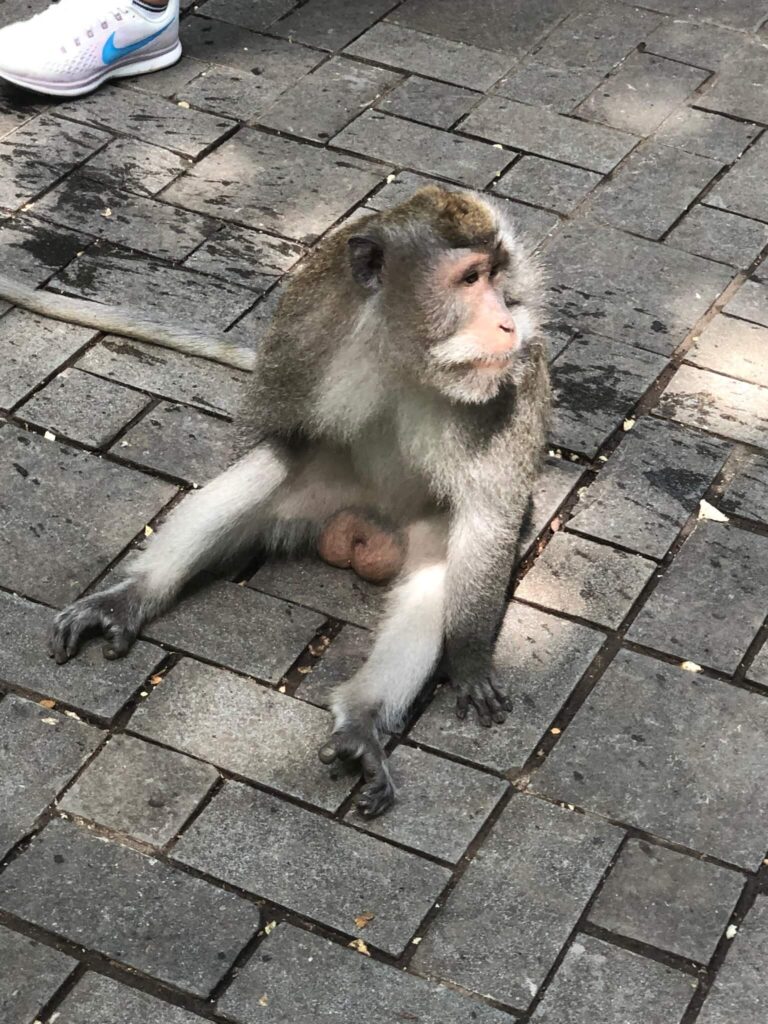
Entry is around IDR 80,000 to 100,000. Afterwards, wander into Nyuh Kuning village just south of the forest for a coffee (about IDR 25,000 to 50,000) and a short stroll through its leafy lanes.
By late morning head north to the Tegalalang Rice Terraces. Walk a loop through the paddies, pay the village contribution (IDR 10,000 to 25,000) plus parking (IDR 5,000 to 10,000), and enjoy the view. If the swing queue looks longer than fifteen minutes, skip it and relax in a terrace café instead.
Take a light lunch overlooking the fields, then return to your hotel for a few hours of rest. In the evening, join a small-group cooking class in town (IDR 350,000 to 500,000 per person, dinner included, most offer hotel pick-up). You will prepare several Balinese dishes and share them with your group at the end.
Where to stay in the jungle: Splurge at The Kayon Jungle Resort (spectacular infinity pools), or go eco‑quiet at Pondok Sebatu Eco Lodge near Sebatu.
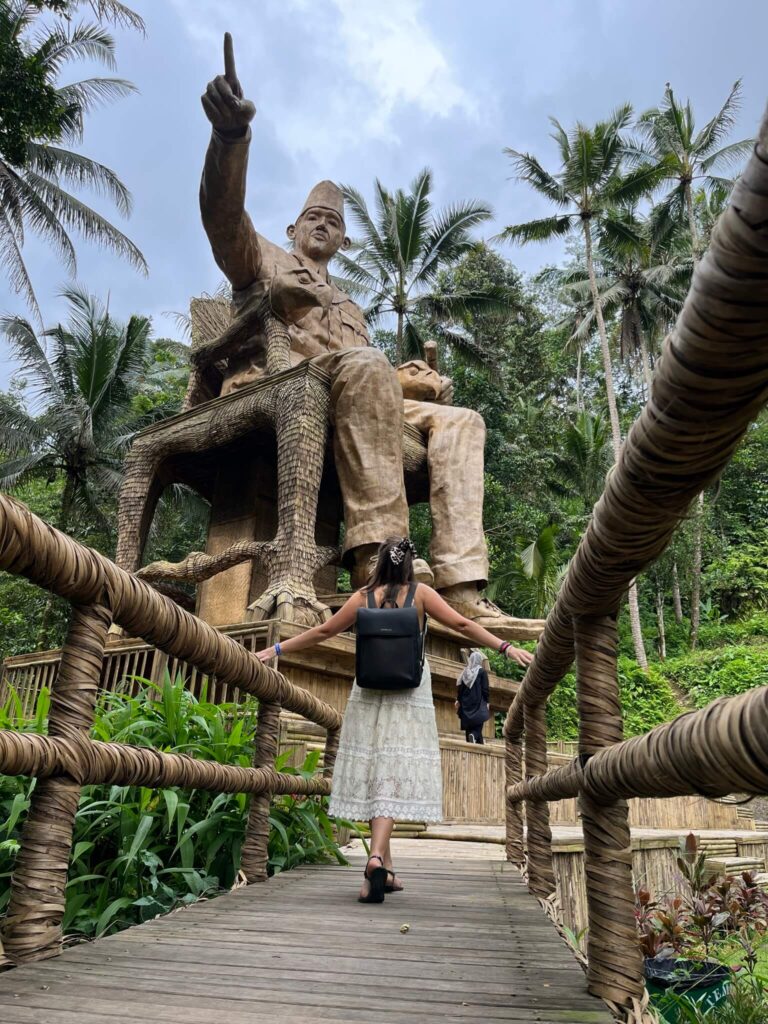
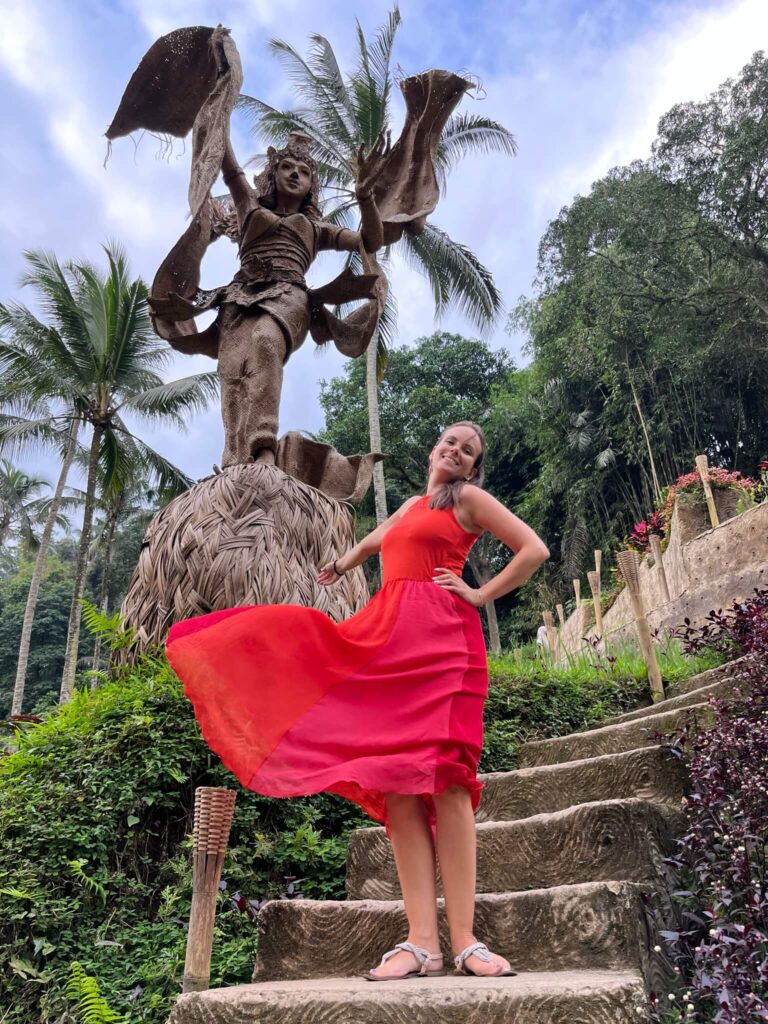
Day 12 – Tirta Empul, Goa Gajah, Sound Healing / Bodywork
Start early at Tirta Empul to join a melukat purification. Bring or borrow a sarong, use the lockers for valuables, and follow the fountain order as directed by staff. It is one of the most moving ways to experience Balinese culture, and the morning hours are quieter.
Afterwards, grab breakfast at a nearby café and continue to Goa Gajah, known as the Elephant Cave. Explore the carved entrance, small shrines, and bathing pools before heading back to town.
There, keep the middle of the day light: brunch, rest, or invest in a gentle massage. After that, consider a group sound-healing session at Pyramids of Chi (~IDR 350,000; book ahead). It’s deeply relaxing – and yes, if you start snoring, they’ll wake you gently.
Want more of Ubud’s spiritual side? We’ve collected extra ideas in our Spiritual Ubud mini‑guide.
Day 13 – Waterfall Morning, Flexible Afternoon, Campuhan Ridge Walk
Reach Tegenungan Waterfall early to beat the crowds (entry ~IDR 20,000–25,000; parking IDR 2,000–5,000). Steps can be wet so we highly recommend to wear grippy sandals. Lockers and changing rooms are available for a small fee. Pair it with nearby Tibumana (entry ~IDR 20,000; gentle walk; swimmable when calm). Prefer fewer people? Swap for Kanto Lampo or Tukad Cepung (note: Tukad Cepung is a longer drive).
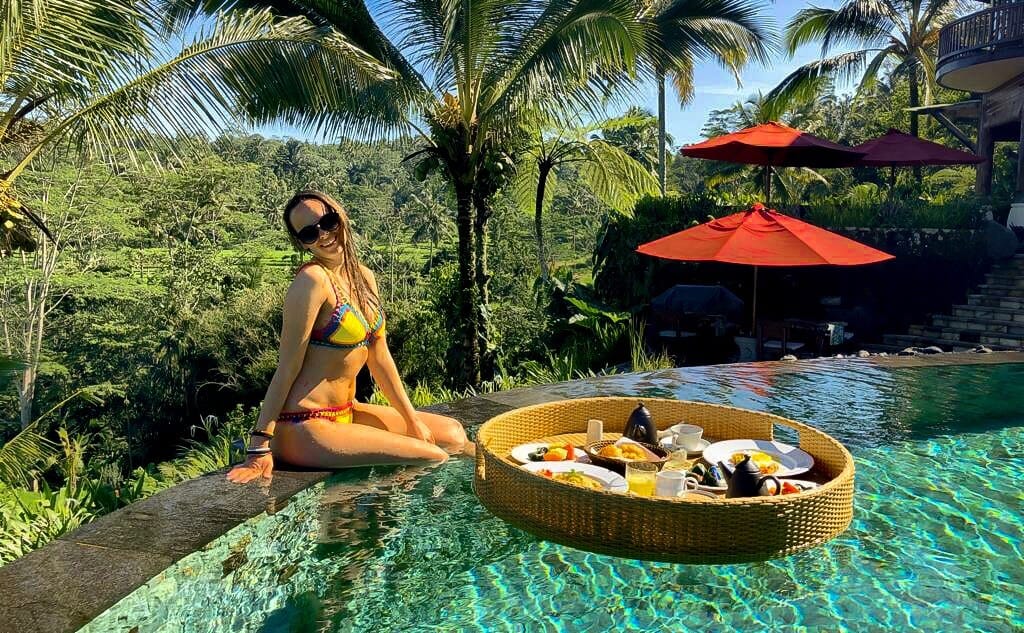
Back in Ubud, leave the afternoon flexible for a café, pool, or massage. Near sunset, walk the Campuhan Ridge: start beside Pura Gunung Lebah (near Warwick Ibah on Jalan Raya Ubud), go down the steps, cross the small bridge, then turn right onto the paved ridge. No ticket needed. The path is exposed and gently rolling for ~2 km to the cafés around Karsa. Return the same way or grab a local ride from the far end, then wrap up with dinner.
Day 14 – Either Mount Batur Sunrise or a Slow Ubud Day
Option A – Mount Batur Sunrise. Book with a licensed guide and be ready for a very early pick-up (~02:00 from Ubud). Pack a light jacket, headlamp, water, and small cash. The climb takes about two hours and sunrise above the clouds is the reward. Add nearby hot springs after the hike if you like; plan extra rest back in town.
Option B – Slow Ubud Day. Sleep in, browse the Ubud Art Market, and join a short workshop to make your own Canang Sari offerings near the market (popular; ~IDR 100,000–150,000 including materials). Afterward, book a massage, visit a gallery or craft studio, and end the day with a dance performance or a sunset café.
Both paths are valid: one gives you a summit memory; the other keeps energy in the tank for cooler air up north.
Munduk and North Bali – Days 15 to 18
Day 15 – Into cooler air
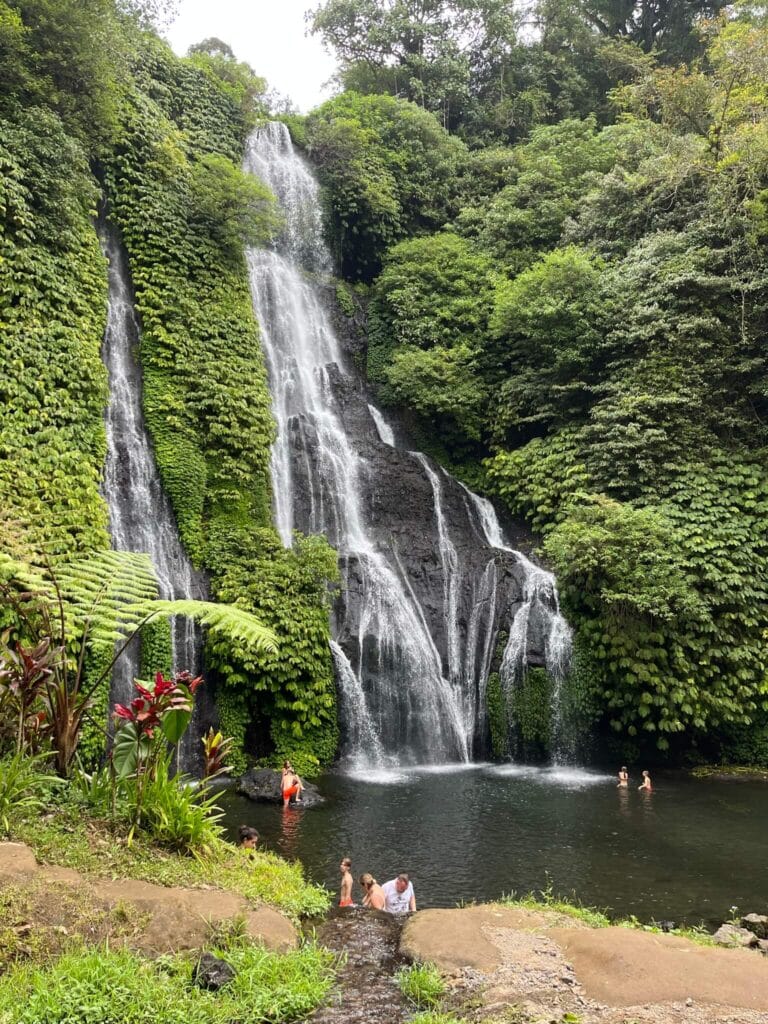
Transfer from Ubud to Munduk along the highland road; as you climb, the air turns crisp and the scenery shifts to clove and coffee farms and misty valleys. Check into a mountainside guesthouse (pack a light layer—nights are cool). In the afternoon, pick one or two of Munduk’s short waterfall trails: Munduk/Red Coral, Melanting, or Golden Valley (each ~15–30 minutes walking; entry IDR 20,000–30,000).
Steps are often wet and mossy—wear grippy shoes and mind the spray. Pause at a local warung for clove tea, or visit a small farm to see how Bali’s coffee and spices are grown. On a scooter, expect hairpins and occasional fog; ride conservatively and be back before dusk for dinner with a view.
Day 16 – Sekumpul’s amphitheater of water
Sekumpul is often called Bali’s most dramatic waterfall complex, with several powerful curtains dropping into a lush jungle bowl. It’s a place that feels wild and raw. If the rain has been heavy and the river is swollen, it’s best to stay at the upper viewpoints and enjoy the panorama from above rather than attempting the base trek. Use the official Sekumpul Village entrance and go with a local guide – they are required here and make the whole experience easier.
From the parking area you can either stop at the viewpoints for wide photos, or follow your guide on the steep descent. The path down is a mix of steps, slick rocks, and shallow stream crossings. After rain the water can rise quickly, sometimes up to your knees, and the current gets strong. Wear strapped sandals or sturdy shoes with grip, pack a dry bag for your phone and camera, and be ready for spray that soaks everything near the base.
If conditions are good, ask your guide to also include the nearby Fiji or Triple Waterfalls, which are just as impressive but less crowded. However far down you go, take it slow, keep drinking water, and listen to your guide. Even if you only stay high at the viewpoints, the scale of Sekumpul makes the trip worthwhile. By the time you return in the afternoon you’ll likely be exhausted, but also carrying one of the most memorable images of Bali.
Day 17 – Twin lakes, temple, and coffee farms
For this day you’ll want a driver again. We hired one who took us all the way north to Lovina, stayed the night, and then drove us back down south the next day. It’s the easiest way to cover several highlights without rushing.
The first stop is the viewpoints above Lakes Tamblingan and Buyan. The air here is cooler, often with morning mist drifting across the ridges. Simple bamboo platforms overlook the twin lakes; expect to pay around IDR 30,000 for entry and photos.
Continue to Ulun Danu Beratan Temple on Lake Beratan near Bedugul. This is the famous water temple with shrines that seem to float on the lake. Entry is about IDR 75,000, and it’s one of the most photographed temples in Bali for a reason.
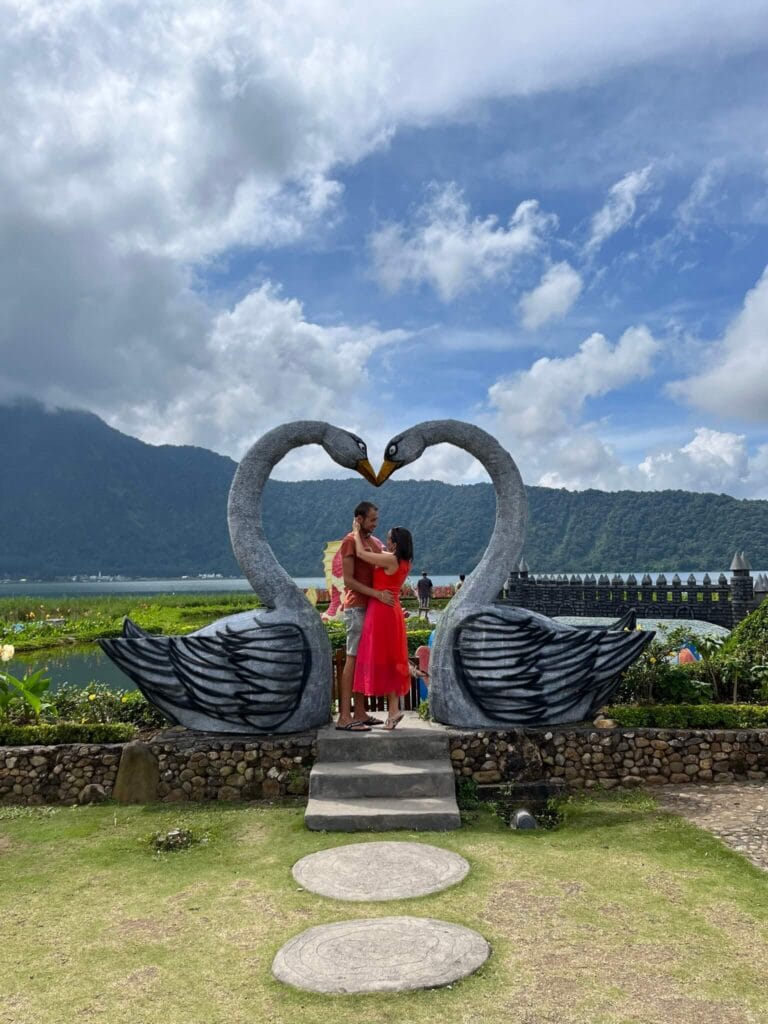
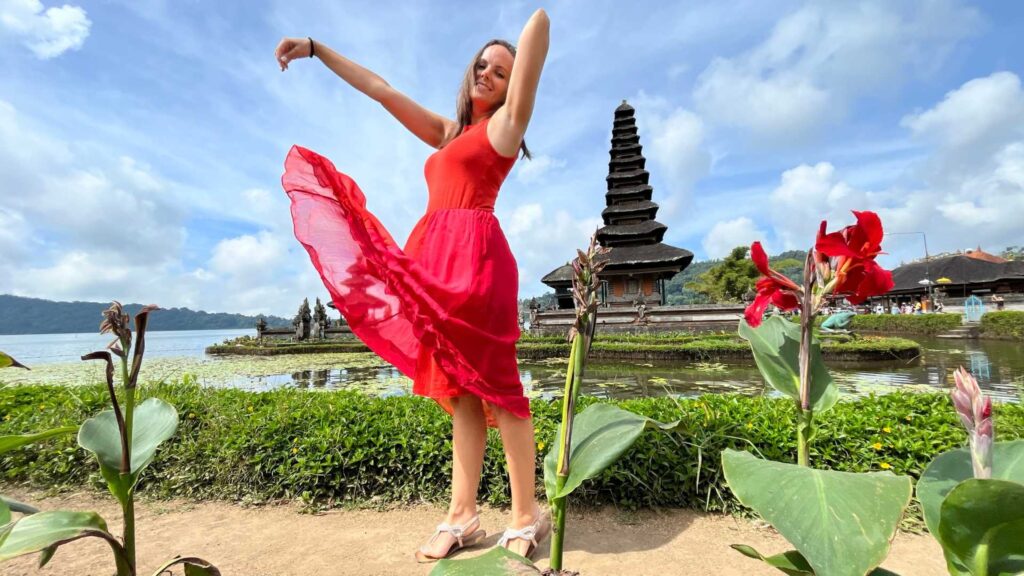
Afterward, stop at a small coffee and spice farm. Most offer a short tour and free tastings, from clove tea to cocoa. Bring some cash if you’d like to buy beans or spices to take home.
Skip the nearby Handara Gate at the golf course unless you’re set on the photo. Queues can stretch for ages and the lakes and temple give far better value for your time.
Plan to be back on the road by about 16:00. The drive down into Lovina takes time and you’ll want to arrive before dark. Once there, check into your stay, take a quiet walk along the black sand beach, and finish with dinner at a local café. If the sea is calm and the night is clear, you can even book a short boat ride to see glowing bioluminescent plankton before bed.
Day 18 – Dolphins at dawn and glowing seas in Lovina
For the dolphines tour you have to wake well before sunrise again and board a small outrigger to watch wild dolphins. If many boats cluster, ask your captain to hold distance or move to a quieter area. Tours usually leave around 06:00 and last two to three hours. Ethical operators slow engines once dolphins are near and keep safe distance so the pods surface naturally. Swimming is optional and only when conditions are calm and the dolphins approach on their own. The result is not a show but a quiet drift with wild animals.
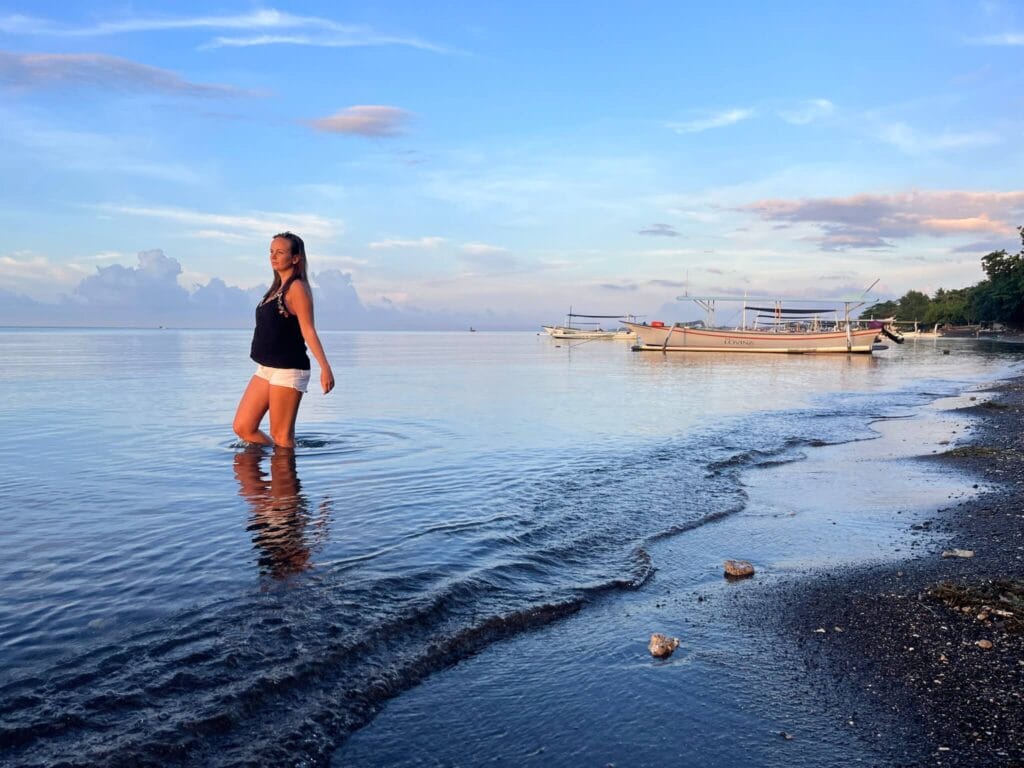
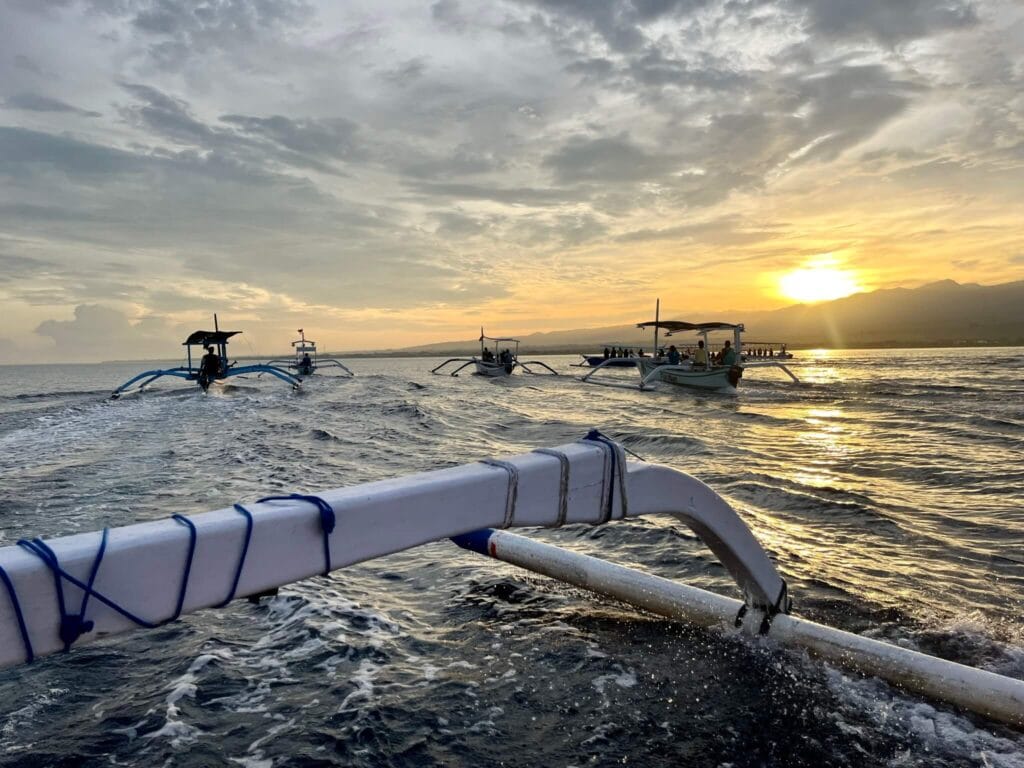
After the tour, share breakfast, rest on the beach or wander Lovina’s streets. In the evening you can join another short boat trip to see bioluminescent plankton – if you have missed it the first day. Lovina is one of the few places in Bali where tourism still feels small and personal. The next morning transfer south toward Canggu.
Canggu and Seminyak – Days 19 to 21
Day 19 – First look at Canggu
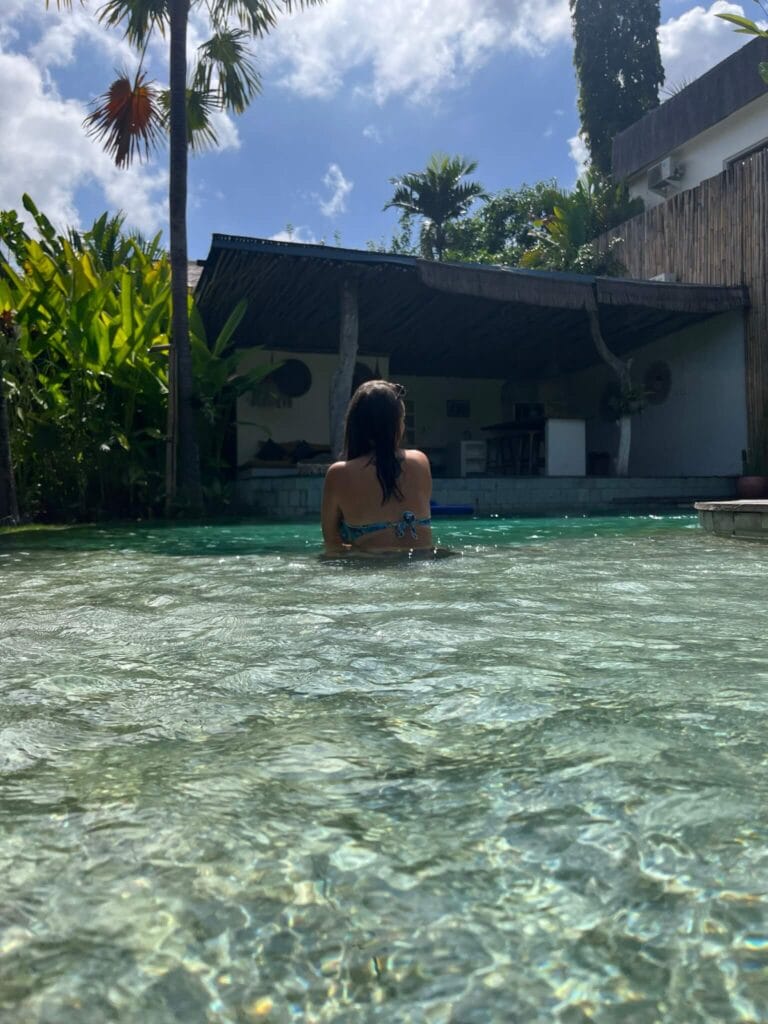
Drive back south and check into your stay in Canggu. Spend the afternoon on Echo Beach, then settle in for sunset with your feet in the sand. The area is full of cafés and beach bars where you can end the evening.
⚠️ Reality check: Traffic in Canggu is heavy almost any time of day. The so-called **Canggu Shortcut** is notorious, and what looks like a five-minute ride on the map can easily take half an hour. Build in extra time and don’t stress — it’s just part of the Canggu experience.
If you need coworking or coliving, check out Shashvata Coliving, our favorite base in Bali for longer stays. For a shorter trip or a splurge, we loved Villa La Payesa with its private pool and quiet vibe.
Food delivery with Grab or Gojek works well in Canggu and Seminyak, but you won’t find reliable service in Sidemen, Munduk, or the Gilis. For dinner, book a table at Sa’mesa in Canggu, a communal Italian dining experience where the motto is come as strangers, leave as friends. Expect plenty of food, laughter, and free-flow limoncello.
Day 20 – Seminyak and Tanah Lot Temple
Spend the morning browsing Seminyak’s boutiques or enjoying a long brunch. In the afternoon relax by the pool or beach. Before sunset head to Tanah Lot Temple. Arrive about an hour early to find a good viewpoint and stay until the sky turns orange.
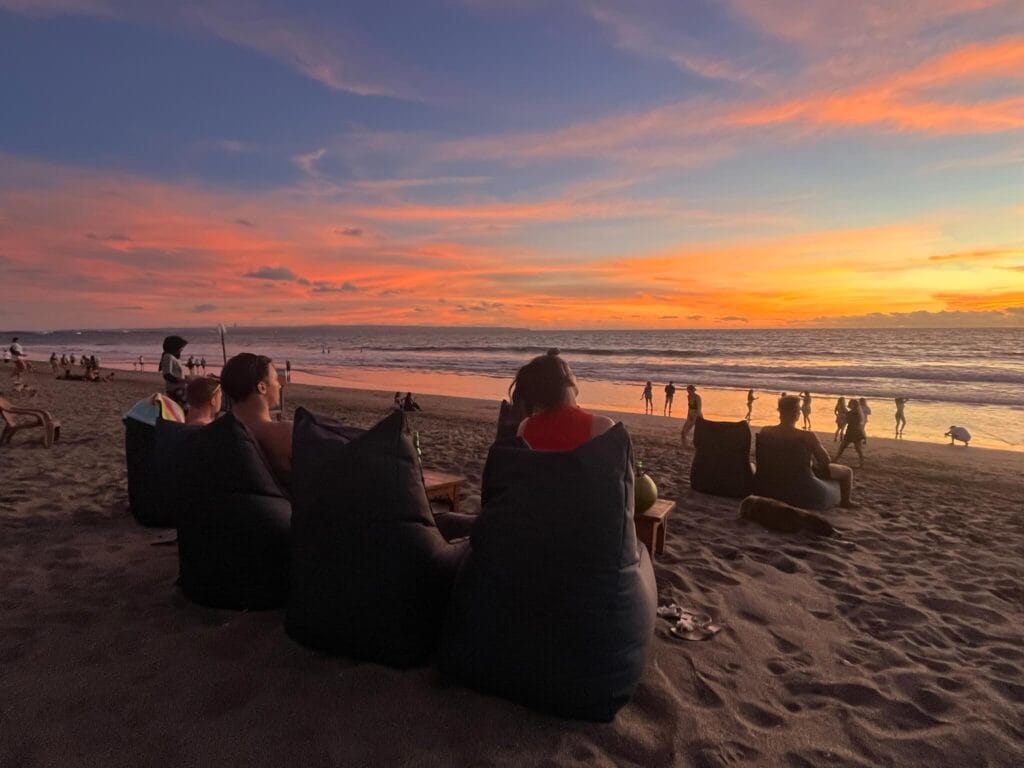
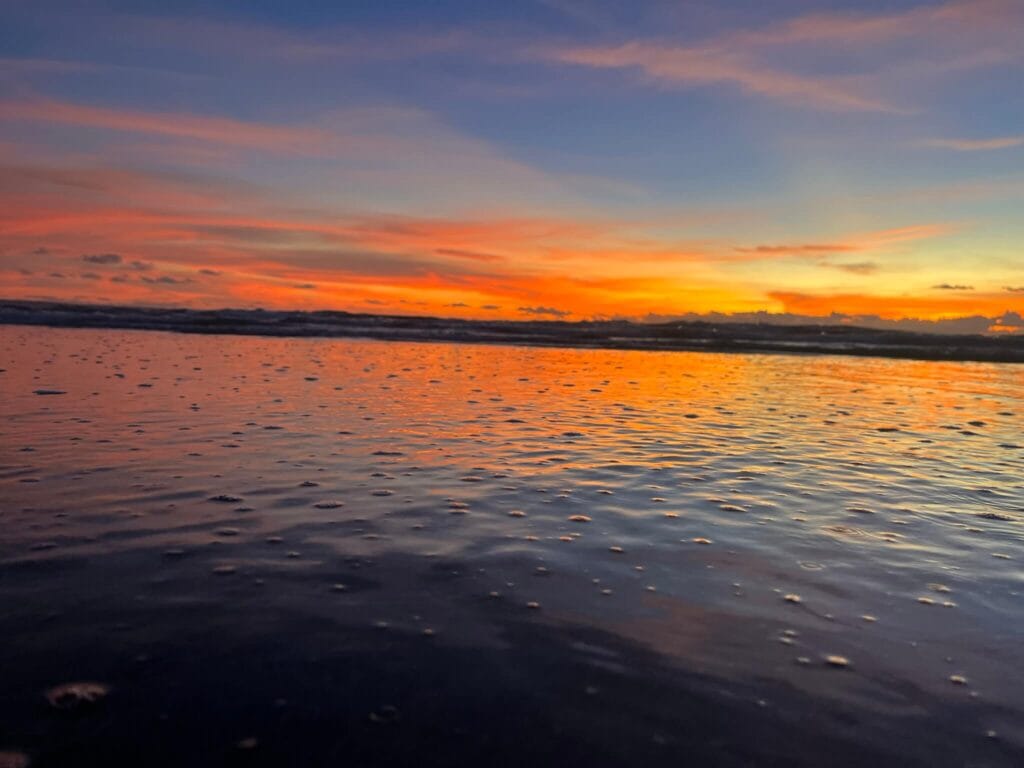
When night falls close your trip with a party. Seminyak has classics like Motel Mexicola for a wild night and La Favela for dancing until late. Canggu offers Old Man’s and Deus for a more casual beach vibe. For a samba beat check out Ku De Ta events. If you want to splurge, Finns Beach Club or Atlas Beach Club serve full luxury with DJs, pools, and ocean views. Wrap up by midnight if you have a morning flight.
Day 21 – A gentle goodbye
Keep the final morning calm with a beach walk or one last smoothie bowl. Take a few minutes to reflect, write in your journal, or browse a craft shop for small gifts. Pack carefully and allow enough time for the airport. You can order a car through Gojek or Grab or ask your stay to arrange transport. Depending on traffic it can take one to one and a half hours. Leave with margin so you end your trip with memories, not stress.
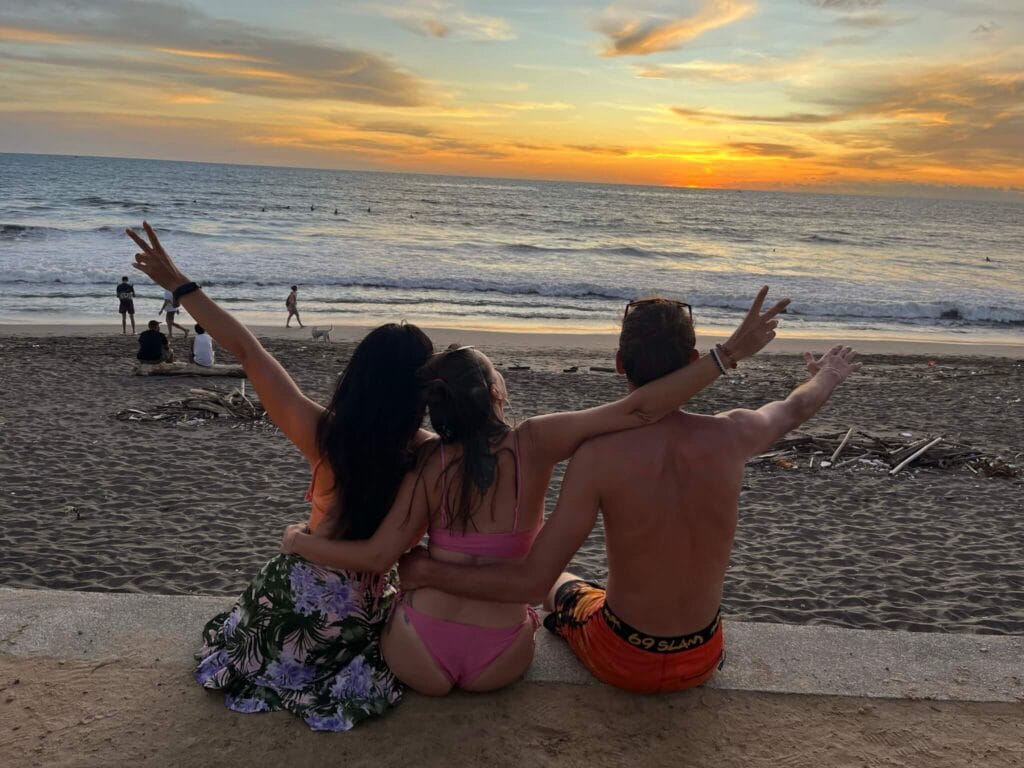
Costs for 3 Weeks in Bali in 2025
Bali stretches to almost any budget. A homestay can be modest, while a private villa can feel indulgent. For mid-range travel in 2025 you should expect around USD 35–83 / EUR 33–79 per person per day, and our own spending stayed close to that.
Most of your money goes toward experiences rather than transport. Scooters are cheap but require confidence, an international driving permit with motorcycle endorsement, and a helmet – police checks can happen. Hiring a day driver costs more but is far less stressful. Tours range from simple local trips to full-service excursions. Alcohol and nightlife raise costs quickly since drinks and clubs are expensive compared to food or lodging.
It’s smart to keep a small buffer in your budget for boat transfers, weather changes, or last-minute splurges.
FAQ – Bali Itinerary in 3 Weeks
Is three weeks in Bali too much?
No. Three weeks is the balance point. You see the main icons without burning out and you still keep rest days. If you prefer to go slower, drop one stop and add a night to Sidemen or Ubud.
What budget should I expect for Bali?
Plan around USD 35–83 / EUR 33–79 per person per day, flights aside. A typical mid-range split per day is: stay $33–67, food $13–27, transport $10–20, activities $13–27. Alcohol and beach clubs raise costs fast. A single night out can double a day’s spend. Big splurges: The Edge half day is 7,000,000 IDR per couple. Beach clubs like Finns or Atlas are premium priced.
When is the best time to visit Bali?
Dry season runs May–October with more sun and easier roads and seas. November to March is rainy. Showers are short but heavy, and the island turns green. April and October are shoulder months with fewer people and some chance of rain. Sea crossings are usually calmer from June to September but always check the day before.
Are the Gili Islands worth visiting?
Yes, if you want car-free islands, turtles, and glowing sunsets. The Gilis belong to Lombok (West Nusa Tenggara), not Bali. Boats run mainly late morning to early afternoon and take about two to three hours. Schedules and seas vary – confirm the day before. Gili Trawangan is lively, Gili Air is balanced, Gili Meno is quiet.
Do I need a license to drive a scooter in Bali?
Yes. Bring an international driving permit with motorcycle class plus your home license. Wear a helmet. Many insurers exclude scooter accidents without a valid permit.
Can I drink tap water in Bali?
No. Use bottled or filtered refills.
Is ice safe to drink in Bali?
At reputable cafés and restaurants, ice is factory-made and delivered by truck and has been fine for us. Avoid homemade ice.
Can I swim at Angel’s Billabong or Broken Beach?
No. Swimming is prohibited due to dangerous waves. Enjoy the view from safe areas only.
Is the Kecak dance at Uluwatu Temple worth it?
Yes. There are two daily shows. Aim for the sunset performance around 18:00. Buy tickets at the temple, arrive early, wear a sarong, and secure belongings from monkeys.
Is Mount Batur sunrise worth it?
Yes, if you want a summit sunrise. Pick-up is around 02:00 from Ubud. A guide is required. Pack a light jacket, water, and consider hot springs afterwards.
How do payments and ATMs work in Bali?
Cards are widely accepted in the south and Ubud. Carry cash for small warungs, tips, and rural areas. ATMs are common in towns. Keep some small notes for temple donations and parking.
Health and Safety Tips
- Do not drink tap water; use bottled or filtered refills.
- Ice at reputable cafés is factory‑made and delivered; avoid homemade.
- If Bali belly hits, rest and rehydrate with ORS. House‑call doctors are professional.
- Travel insurance is essential.
- If bitten by a monkey or dog, seek rabies treatment immediately.
- Use reef‑safe sunscreen, respect currents.
- For temples carry a sarong and be mindful of ceremonies.
Travel Tips for 3 Weeks in Bali
- SIM: Airalo eSIM activates in minutes. Telkomsel is strongest for coverage; buy at official kiosks with passport. Top‑up via app or minimarkets. Expect mostly 4G, weaker on Nusa Penida and Gilis. Download offline maps.
- Visa: Visa on Arrival at DPS for many passports; valid 30 days, extendable to 60. Consider e‑VoA online. Passport must be valid 6+ months, onward ticket required.
- Packing: Light layers, rain jacket, steady shoes, dry bag, waterproof pouch, reef‑safe sunscreen, quick‑dry towel, small first aid kit with ORS and motion tablets.
- Power: Indonesia uses Type C/F plugs with 230V. Carry a universal adapter.
Conclusion
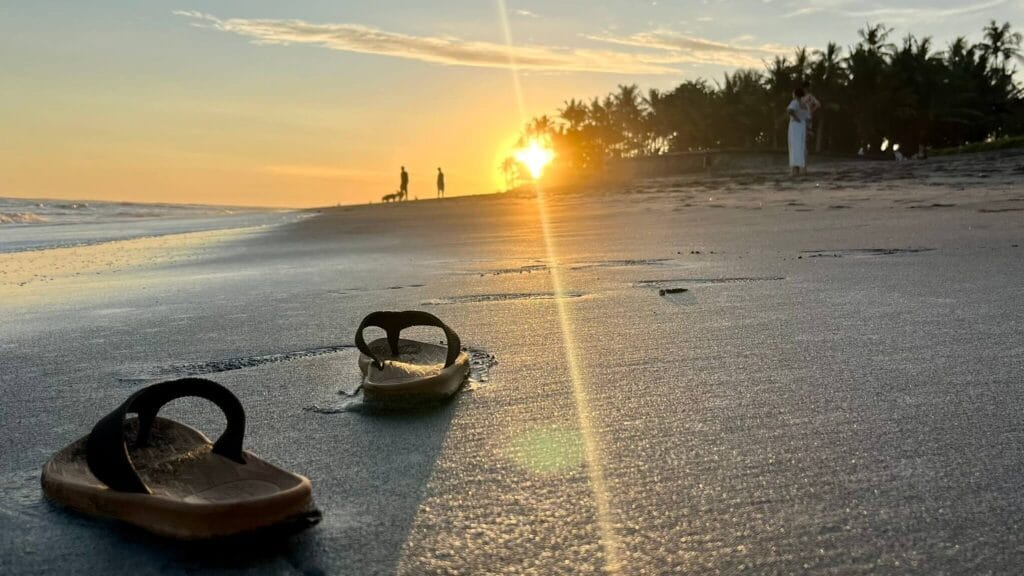
Three weeks in Bali gives you more than just a holiday — it gives you rhythm. It’s the difference between ticking off sights and actually living a few slow, extraordinary days in each region. You wake to jungle sounds in Ubud, hear the ocean echo off the cliffs in Uluwatu, cool down in the mist of northern waterfalls, and ride a bike along the sandy paths of the Gilis where no cars exist.
Our hope with this itinerary is not only to tell you where to go, but to help you feel how to move through Bali. Not rushed, not rigid. Flexible, present, and full of discovery.
Happy travels – Ellis & Mario 🧡


